三维电解剖标测系统
- 格式:ppt
- 大小:5.01 MB
- 文档页数:10

三维电解剖标测系统指导射频消融术治疗心房颤动的护理张晓华;邵爱英
【期刊名称】《现代护理》
【年(卷),期】2007(013)09Z
【摘要】目的探讨三维电解剖标测系统指导射频消融术治疗心房颤动的临床治疗效果观察及其护理。
方法对37例接受三维标测系统指导射频消融术治疗心房颤动患者的护理措施进行分析。
结果37例患者射频消融治疗后,27例根治,10例有效。
结论充分良好的术前准备、术中配合、术后监护及康复指导,是手术治疗成功的重要保障。
【总页数】2页(P2468-2469)
【作者】张晓华;邵爱英
【作者单位】无锡市第一人民医院十九病区心内科;,214002
【正文语种】中文
【中图分类】R473.5
【相关文献】
1.三维电解剖标测系统指导射频消融术治疗心房颤动的护理 [J], 张晓华;邵爱英
2.联合应用磁共振扫描与三维电解剖标测系统图像融合技术及Lasso导管标测技术指导环肺静脉隔离治疗心房颤动 [J], 徐亚伟;唐恺;马坚;张敬莹;周可;于学靖;陈艳清
3.三维电解剖标测系统联合CT影像融合技术指导心房颤动环肺静脉电隔离术的临床研究 [J], 范晓涛;陈晓敏;沈才杰;储慧民;何斌;刘晶;郁一波;丰明俊;孙立勤;庄丽频
4.精细化护理在对心房颤动患者进行Carto三维标测系统指导下房颤射频消融术中
的应用 [J], 王咏梅;冯琳
5.两种三维电解剖标测系统结合CT影像融合技术指导阵发性心房颤动环肺静脉电隔离的随机对照研究 [J], 龚世峰;沈才杰;陈晓敏;王健;储慧民
因版权原因,仅展示原文概要,查看原文内容请购买。
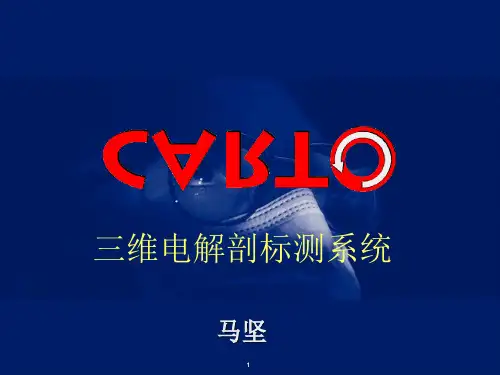

中国血液流变学杂志.2020;30(3)311 doi:10.3969/j.issn.1009-881X.2020.03.010三维电解剖标测系统在指导射频消融治疗靶点邻近房室传导系统心律失常中的应用王小青,程亚敏,钱波,王卫明,邵山,杨玲(常州市第一人民医院心内科,江苏常州 213003)摘要:目的回顾射频消融治疗靶点邻近房室传导系统心律失常的病例,评价在三维电解剖标测系统(Carto3)指导下导管消融的有效性及安全性。
方法常州市第一人民医院心血管内科2010年02月—2020年07月经电生理检查及射频消融明确其消融靶点邻近房室传导系统的心律失常共942 例,包括房室结折返性心动过速(AVNRT)863 例,右侧间隔部旁道介导的房室折返性心动过速(AVRT)48 例,右侧间隔部房性心动过速(AT)9 例,邻近房室结和希浦系统的室性早搏(PVC)22 例。
于二维影像指导下标测消融定义为传统组,于Carto3指导下标测消融定义为三维组,比较两组之间消融治疗的有效性和安全性。
结果所有病例均完成射频消融,其中发生永久性Ⅲ°房室传导阻滞(A VB)4 例,发生率0.42%。
传统组576 例,发生永久性Ⅲ°A VB 4 例,发生率0.69%,其中A VNRT 3 例,左中间隔PVC 1 例。
三维组366 例,未发生永久性A VB。
结论靶点邻近房室传导系统的心律失常行射频消融时有发生A VB的风险,三维电解剖标测系统指导标测消融该类型心律失常不仅可提高有效性,亦有助于减少发生永久性A VB的风险。
关键词:三维电解剖标测系统;心律失常;射频消融;房室传导阻滞中图分类号:R563.1 文献标识码:A 文章编号:1009-881X(2020)03-0311-03 Application of Three-dimensional Electroanatomical Mapping System in Guiding Radiofrequency Catheter Ablation of Arrhythmias with the Targets Adjacent to the Atrioventricular Conduction SystemWANG Xiao-qing, CHENG Ya-min, QIAN Bo, WANG Wei-ming, SHAO Shan, YANG Ling (Department of Cardiology, Changzhou First People's Hospital, Changzhou, Jiangsu, 213003, China)Abstract:Objective To review the cases of arrhythmias with the targets adjacent to the atrioventricular conduction system treated by radiofrequency catheter ablation (RFCA) and to evaluate the efficacy and safety of RFCA under the guidance of the three-dimensional (3D) electrical anatomical mapping system (Carto3). Methods From February 2010 to July 2020, electrophysiological study (EPS) and RFCA were performed on 942 patients with arrhythmias and the targets were adjacent to the atrioventricular conduction system in cardiovascular department of Changzhou First People's Hospital, including 863 cases of atrioventricular node reentrant tachycardia (A VNRT), 48 cases of atrioventricular reentrant tachycardia (A VRT) mediated by right septal bypass, 9 cases of right septal atrial tachycardia (AT), and 22 cases of premature ventricular contraction (PVC) originating near the atrioventricular node and the His-Purkinje system. The conventional group was defined as 2-dimensional (2D) image- guided ablation and the 3D group as Carto3-guided ablation, thus comparing the efficacy and safety of the two groups. Results RFCA was performed in all cases. Permanent Ⅲ° atrioventricular block (AVB) occurred in 4 patients (3 patients were diagnosed with A VNRT and 1 with PVC originating from left ventricular 收稿日期:2020-08-29 作者简介:王小青(1977—),男,江苏金坛人,硕士,副主任医师,研究方向为心电生理与起搏。
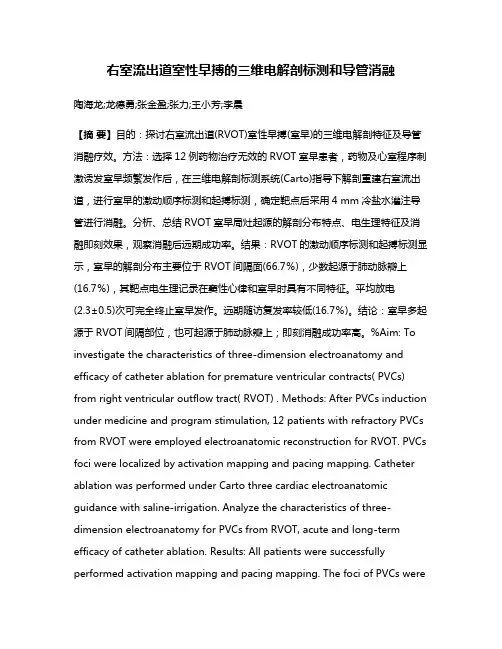
右室流出道室性早搏的三维电解剖标测和导管消融陶海龙;龙德勇;张金盈;张力;王小芳;李晨【摘要】目的:探讨右室流出道(RVOT)室性早搏(室早)的三维电解剖特征及导管消融疗效。
方法:选择12例药物治疗无效的RVOT室早患者,药物及心室程序刺激诱发室早频繁发作后,在三维电解剖标测系统(Carto)指导下解剖重建右室流出道,进行室早的激动顺序标测和起搏标测,确定靶点后采用4 mm冷盐水灌注导管进行消融。
分析、总结RVOT室早局灶起源的解剖分布特点、电生理特征及消融即刻效果,观察消融后远期成功率。
结果:RVOT的激动顺序标测和起搏标测显示,室早的解剖分布主要位于RVOT间隔面(66.7%),少数起源于肺动脉瓣上(16.7%),其靶点电生理记录在窦性心律和室早时具有不同特征。
平均放电(2.3±0.5)次可完全终止室早发作。
远期随访复发率较低(16.7%)。
结论:室早多起源于RVOT间隔部位,也可起源于肺动脉瓣上;即刻消融成功率高。
%Aim: To investigate the characteristics of three-dimension electroanatomy and efficacy of catheter ablation for premature ventricular contracts( PVCs) from right ventricular outflow tract( RVOT) . Methods: After PVCs induction under medicine and program stimulation, 12 patients with refractory PVCs from RVOT were employed electroanatomic reconstruction for RVOT. PVCs foci were localized by activation mapping and pacing mapping. Catheter ablation was performed under Carto three cardiac electroanatomic guidance with saline-irrigation. Analyze the characteristics of three-dimension electroanatomy for PVCs from RVOT, acute and long-term efficacy of catheter ablation. Results: All patients were successfully performed activation mapping and pacing mapping. The foci of PVCs weremainly distributed at the septal plane of RVOT(66. 7% ) , while exceptional cases above the pulmonary artery valve( 16. 7% ) with a novel characteristics during sinus rhythm and PVCs onset. After (2. 3 ±0. 5) firing tries, PVCs was terminated completely with a benign follow-up results. Conclusion: PVCs of RVOT are mainly localized at septal plane of RVOT while rare cases above pulmonary artery valve. Catheter ablation can effectively eliminate PVCs of RVOT.【期刊名称】《郑州大学学报(医学版)》【年(卷),期】2011(046)004【总页数】4页(P547-550)【关键词】右室流出道;室性早搏;电解剖标测;导管消融【作者】陶海龙;龙德勇;张金盈;张力;王小芳;李晨【作者单位】郑州大学第一附属医院心内科,郑州450052;北京安贞医院心内科,北京100029;郑州大学第一附属医院心内科,郑州450052;郑州大学第一附属医院心内科,郑州450052;郑州大学第一附属医院心内科,郑州450052;郑州大学第一附属医院心内科,郑州450052【正文语种】中文【中图分类】R541.7室性早搏(室早)是最常见的心律失常,可长期存在并呈间断发作,引起心悸、胸闷等不适。
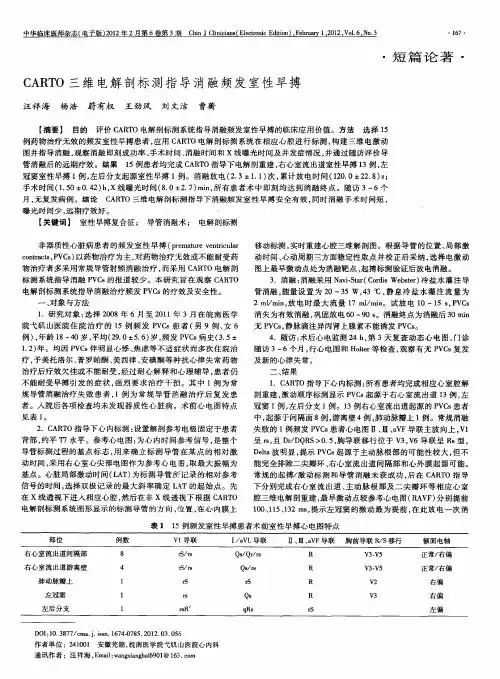


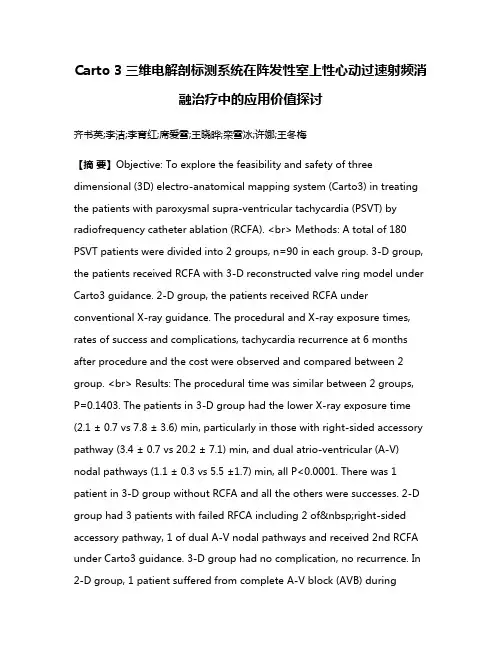
Carto 3三维电解剖标测系统在阵发性室上性心动过速射频消融治疗中的应用价值探讨齐书英;李洁;李育红;席爱雪;王晓晔;栾雪冰;许娜;王冬梅【摘要】Objective: To explore the feasibility and safety of three dimensional (3D) electro-anatomical mapping system (Carto3) in treating the patients with paroxysmal supra-ventricular tachycardia (PSVT) by radiofrequency catheter ablation (RCFA). <br> Methods: A total of 180 PSVT patients were divided into 2 groups, n=90 in each group. 3-D group, the patients received RCFA with 3-D reconstructed valve ring model under Carto3 guidance. 2-D group, the patients received RCFA under conventional X-ray guidance. The procedural and X-ray exposure times, rates of success and complications, tachycardia recurrence at 6 months after procedure and the cost were observed and compared between 2 group. <br> Results: The procedural time was similar between 2 groups, P=0.1403. The patients in 3-D group had the lower X-ray exposure time (2.1 ± 0.7 vs 7.8 ± 3.6) min, particularly in those with right-sided accessory pathway (3.4 ± 0.7 vs 20.2 ± 7.1) min, and dual atrio-ventricular (A-V) nodal pathways (1.1 ± 0.3 vs 5.5 ±1.7) min, all P<0.0001. There was 1 patient in 3-D group without RCFA and all the others were successes. 2-D group had 3 patients with failed RFCA including 2 of right-sided accessory pathway, 1 of dual A-V nodal pathways and received 2nd RCFA under Carto3 guidance. 3-D group had no complication, no recurrence. In 2-D group, 1 patient suffered from complete A-V block (AVB) duringablation and 1-year later, the Holter showed II° to III° AVB;2 patients with recurrence including 1 of dual A-V nodal pathways and had successful 2nd ablation. The cost was higher in 3-D treatment. <br> Conclusion: RFCAwas feasible for treating PSVT patients under Carto3 guidance, which had the higher success rate with lower X-ray exposure and complication.%目的:探讨三维电解剖标测系统(Carto3系统)指导下阵发性室上性心动过速(阵发性室上速)射频消融的可行性及安全性。
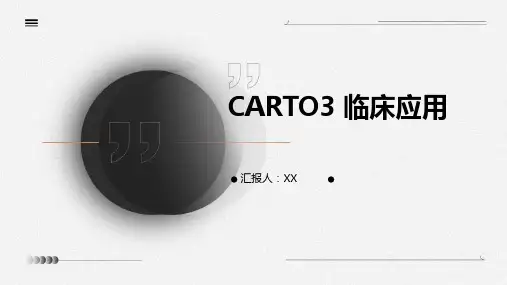


CARTO3三维标测系统快速解剖建模在阵发性心房颤动射频消融术中的应用田野;杨龙;郑亚西;刘晓桥;刘志琴;范寿年;殷跃辉【摘要】Objective: To investigate the safety and efficacy of CARTO3 fast anatomical mapping during radiofrequency ablation in patients with paroxysmal atrial ifbrillation (PAF). Methods: A total of 120 PAF patients treated in our hospital from 2013-01 to 2015-07 were enrolled. All patients received CARTO3 system for mapping and they were randomly divided into 2 groups: Control group, the patients had selective pulmonary vein angiography, followed by conventional point by point method to reconstruct left atrial model for guiding the ablation of PFA and Treatment group, the patients had selective pulmonary vein angiography followed by fast anatomical mapping to build left atrial model for guiding the ablation of PFA; the rest operational steps such as trans-septal and circumferential pulmonary vein ablation were the same.n=60 in each group. The times of operation, X-ray exposure and the rates of success, complication occurrence were compared between 2 groups. Results: All patients were successfully completed radiofrequency ablation for PAF. Compared with Control group, Treatment group had increased modeling time (8.5 ± 3.6) min vs (5.2 ± 2.3) min, while decreased pulmonary vein ostium determing time (12.0 ± 5.6) min vs (25.0 ± 8.4) min, circumferential pulmonary vein ablation time (95.0 ± 22.0) min vs (115.0 ± 25.0) min and X-ray exposure time (15.0 ± 6.3) min vs (24.0 ±5.5) min, allP<0.05. The rates of success andcomplication occurrence were similar between 2 groups, P>0.05. Conclusion: CARTO3 fast anatomical mapping is safe and effective for guiding radiofrequency ablation in PAF patients, it may decrease the X-ray exposure time and operation time which were important for treating the relevant patients.%目的:探讨CARTO3三维标测系统快速解剖建模在阵发性心房颤动(房颤)射频消融术中的安全性及有效性。